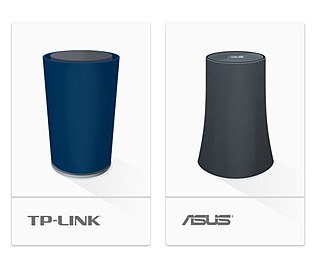
IEEE 802.11 is part of the IEEE 802 set of local area network (LAN) technical standards, and specifies the set of media access control (MAC) and physical layer (PHY) protocols for implementing wireless local area network (WLAN) computer communication. The standard and amendments provide the basis for wireless network products using the Wi-Fi brand and are the world's most widely used wireless computer networking standards. IEEE 802.11 is used in most home and office networks to allow laptops, printers, smartphones, and other devices to communicate with each other and access the Internet without connecting wires.

Wi-Fi is a family of wireless network protocols, based on the IEEE 802.11 family of standards, which are commonly used for local area networking of devices and Internet access, allowing nearby digital devices to exchange data by radio waves. These are the most widely used computer networks in the world, used globally in home and small office networks to link desktop and laptop computers, tablet computers, smartphones, smart TVs, printers, and smart speakers together and to a wireless router to connect them to the Internet, and in wireless access points in public places like coffee shops, hotels, libraries and airports to provide the public Internet access for mobile devices.

High Speed 1 (HS1), legally the Channel Tunnel Rail Link (CTRL), is a 67-mile (108 km) high-speed railway linking London with the Channel Tunnel.

In computer networking, a wireless access point (WAP), or more generally just access point (AP), is a networking hardware device that allows other Wi-Fi devices to connect to a wired network. As a standalone device, the AP may have a wired connection to a router, but, in a wireless router, it can also be an integral component of the router itself. An AP is differentiated from a hotspot which is a physical location where Wi-Fi access is available.

A wireless Internet service provider (WISP) is an Internet service provider with a network based on wireless networking. Technology may include commonplace Wi-Fi wireless mesh networking, or proprietary equipment designed to operate over open 900 MHz, 2.4 GHz, 4.9, 5, 24, and 60 GHz bands or licensed frequencies in the UHF band, LMDS, and other bands from 6 GHz to 80 GHz.

Worldwide Interoperability for Microwave Access (WiMAX) is a family of wireless broadband communication standards based on the IEEE 802.16 set of standards, which provide physical layer (PHY) and media access control (MAC) options.
Linksys is an American brand of data networking hardware products mainly sold to home users and small businesses. It was founded in 1988 by the couple Victor and Janie Tsao, both Taiwanese immigrants to the United States. Linksys products include WiFi routers, mesh WiFi systems, Wifi extenders, access points, network switches, WiFi networking and smart home automation products. It is headquartered in Irvine, California.
H5, H05 or H-5 may refer to:

The AQM-37 Jayhawk is an air-launched supersonic target drone manufactured by Beechcraft capable of simulating inbound ICBM warhead packages for fleet shoot-down exercises.

Regional Eurostar was a planned Eurostar train service from Paris and Brussels to locations in the United Kingdom beyond London. The services would have been run using a fleet of seven North of London, 14-coach British Rail Class 373/3 trainsets.

Viasat Inc. is an American communications company based in Carlsbad, California, with additional operations across the United States and worldwide. Viasat is a provider of high-speed satellite broadband services and secure networking systems covering military and commercial markets.

Arogyaswami J. Paulraj is an Indian-American electrical engineer, academic. He is a Professor Emeritus in the Dept. of Elect. Engg. at Stanford University.

High Speed 2 (HS2) is a planned high-speed railway network in England in three phases, with the first phase between London and Birmingham. As of 2021 phase 1 was under construction, phase 2a, from Birmingham to Crewe, awaited funding approval, and the specification for phase 2b, between Crewe and Manchester and between Birmingham and Leeds, had not been finalised. The railway will be the country's second purpose-built high-speed line, the first being High Speed 1 (HS1) which connects London to the Channel Tunnel. With a "Y"-shaped network of track and a design speed of 400 km/h (250 mph), the new railway will link London with Birmingham, Manchester and Leeds. Some HS2 trains will be able to run on the existing conventional network, reaching locations off the HS2 network using mixed HS2/conventional network services.

TP-Link Technologies Co., Ltd., is a Chinese manufacturer of computer networking products based in Shenzhen, Guangdong, China.
HS3 or HS-3 may refer to:
Li-Fi is a wireless communication technology which utilizes light to transmit data and position between devices. The term was first introduced by Harald Haas during a 2011 TEDGlobal talk in Edinburgh.
BharatNet, also known as Bharat Broadband Network Limited, is a government-owned broadband infrastructure provider, set up by the Department of Telecommunications, a department under Ministry of Communications of the Government of India for the establishment, management, and operation of the National Optical Fibre Network to provide a minimum of 100 Mbit/s broadband connectivity to all 250,000-gram panchayats in the country, covering nearly 625,000 villages, by improving the middle layer of nation-wide broadband internet in India to achieve the goal of Digital India.
HS1, or High Speed 1, is the high-speed Channel Tunnel Rail Link running south from London to the tunnel between England and France.

Google OnHub is a residential wireless router product from Google, Inc. The two variants are manufactured by TP-Link and ASUS. Google's official tagline for the product is "We’re streaming and sharing in new ways our old routers were never built to handle. Meet OnHub, a router from Google that is built for all the ways you use Wi-Fi." In 2016, Google released the Google Wifi router with mesh networking, and combined its functionality and network administration with the OnHub so that OnHub and Google Wifi may both be used interchangeably in mesh networks.

HS4Air was a proposal for a 140-kilometre (87 mi) high-speed railway line in the United Kingdom, put forward in 2018 by a British engineering consultancy, Expedition Engineering.













